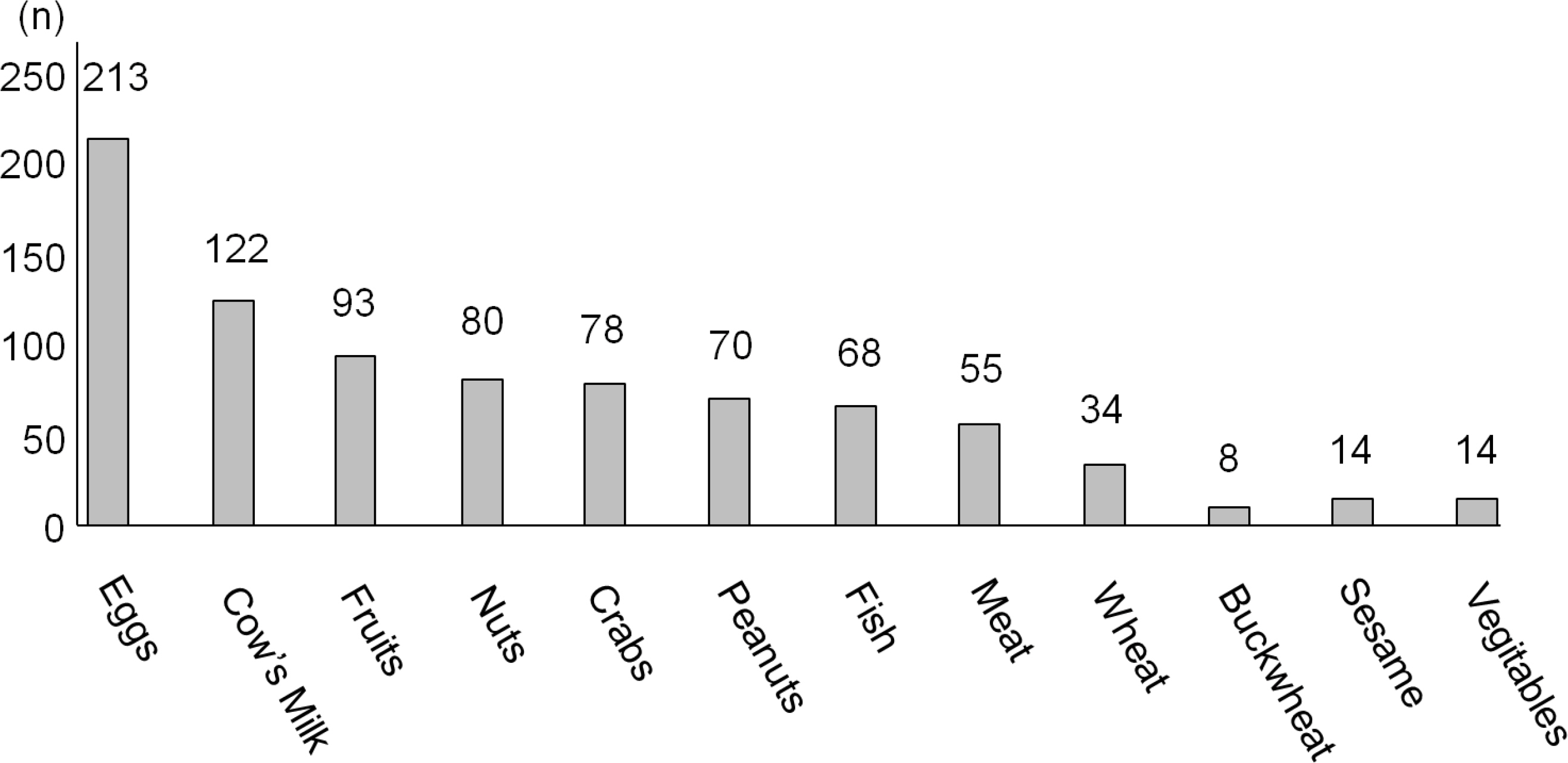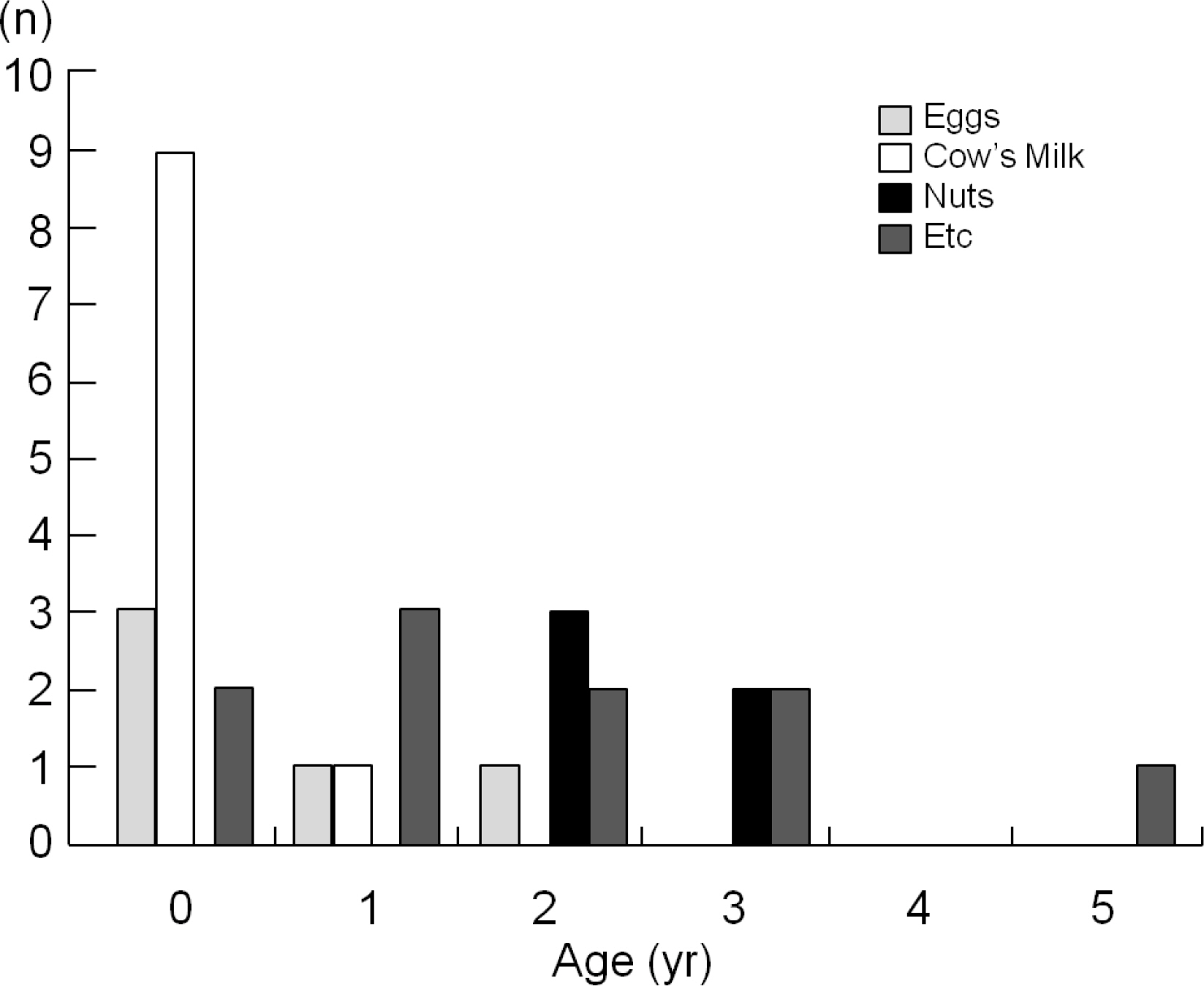Pediatr Allergy Respir Dis.
2011 Mar;21(1):32-38.
Management of Food Allergies in Young Children at a Child Care Center and Hospital in Korean
- Affiliations
-
- 1Department of Pediatrics, Korea University College of Medicine, Seoul, Korea.
- 2Department of Pediatrics, Samsung Medical Center, Sungkyunkwan University School of Medicine, Seoul, Korea. snuhan@gmail.com
Abstract
- PURPOSE
We studied the management of young children with histories of food allergies at child care centers, along with the diagnosis and follow-up management after a visit to a hospital emergency department (ED).
METHODS
1) The survey was conducted in April 2010 in Seoul, Korea. Three hundred forty-five child care centers caring for children between the ages of 0 and 5 years were contacted by mail. The questionnaire was designed to identify symptoms and management of children in child care centers with histories of food allergies. 2) We studied children who were diagnosed with angioedema or anaphylaxis between January 2002 and August 2010 in the ED of Korea University.
RESULTS
1) According to the 345 collected questionnaires, 243 child care centers asked parents about their children's allergic diseases and 492 children had food allergies. A reported 461 children from 207 child care centers had food restrictions. Only 21 child care centers supplied substitute foods with the same amounts and types of nutrients. One hundred forty-five teachers had received education about food allergies. 2) Thirty children were diagnosed with anaphylaxis or angioedema after food ingestion. Only seven children visited a physician after being discharged from the ED.
CONCLUSION
This study identified a lack of food allergy education at child care centers and in homes. Child care centers need to be equipped with knowledge to prevent severe allergic reactions. Also, parents should know more about the importance of food allergies in their children.
MeSH Terms
Figure
Reference
-
References
1. Allen KJ, Hill DJ, Heine RG. 4. Food allergy in childhood. Med J Aust. 2006; 185:394–400.
Article2. Sampson HA. Adverse reactions to foods. In: Adkinson JNF, BS B, JW Y, ST H, WW B, FER S, editors. Middleton's allergy: principle and practice 6th ed. St. Louise Mosby. 2003. 1619–43.3. Sicherer SH, Sampson HA. Food allergy. J Allergy Clin Immunol. 2010; 125(2 Suppl):116S–25S.
Article4. Rona RJ, Keil T, Summers C, Gislason D, Zuidmeer L, Sodergren E, et al. The prevalence of food allergy: a metaanalysis. J Allergy Clin Immunol. 2007; 120:638–46.
Article5. The Korean Academy of Pediatric Allergy and Respiratory disease Committee on Epidemiology. The epidemiologic survey of allergic disease in Korean children-adolescent: Atopic dermatitis and food allergy. 2002; Suppl 1:57–60.6. Simons FER. Anaphylaxis: Recent advances in assessment and treatment. J Allergy Clin Immunol. 2009; 124:625–36.
Article7. Simons FER. Anaphylaxis. J Allergy Clin Immunol. 2010; 125(2 supple):161S–81S.
Article8. Lim DH. Epidemiology of anaphylaxis in Korean children. Korean J Pediatr. 2008; 51:351–4.
Article9. Imamura T, Kanagawa Y, Ebisawa M. A survey of patients with self-reported severe food allergies in Japan. Pediatr Allergy Immunol. 2008; 19:270–4.
Article10. Food Allergy & Anaphylaxis Alliance. Available from:. http://www.foodallergyalliance.org/.11. Sampson HA, Muñoz-Furlong A, Campbell RL, Adkinson JNF, Allan Bock S, Branum A, et al. Second Symposium on the Definition and Management of Anaphylaxis: Summary Report –Second National Institute of Allergy and Infectious Disease/Food Allergy and Anaphylaxis Network Symposium. Ann Emerg Med. 2006; 47:373–80.12. Mehl A, Wahn U, Niggemann B. Anaphylactic reactions in children-a questionnaire-based survey in Germany. Allergy. 2005; 60:1440–5.13. Roh EJ, Chung EH, Lee MH, Lee SJ, Youn YS, Lee JH, et al. Clinical Features of Anaphylaxis in the Middle Area of South Korea. Pediatr Allergy Respir Dis(Korea). 2008; 18:61–9.14. Zuidmeer L, Goldhahn K, Rona RJ, Gislason D, Madsen C, Summers C, et al. The prevalence of plant food allergies: a systematic review. J Allergy Clin Immunol. 2008; 121:1210–8.
Article15. Yunginger JW. Lethal food allergy in children. N Engl J Med. 1992; 327:421–2.
Article16. Wuthrich B. Lethal or life-threatening allergic reactions to food. J Investig Allergol Clin Immunol. 2000; 10:59–65.17. Young MC, Munoz-Furlong A, Sicherer SH. Management of food allergies in schools: a perspective for allergists. J Allergy Clin Immunol. 2009; 124:175–82.
Article18. Fatal anaphylactic reactions to food in children. Allergy Section, Canadian Paediatric Society. CMAJ. 1994; 150:337–9.19. Sampson HA, Mendelson L, Rosen JP. Fatal and near-fatal anaphylactic reactions to food in children and adolescents. N Engl J Med. 1992; 327:380–4.
Article20. Munoz-Furlong A. Food allergy in schools: concerns for allergists, pediatricians, parents, and school staff. Ann Allergy Asthma Immunol. 2004; 93(5 suppl 3):47S–50S.21. Uguz A, Lack G, Pumphrey R, Ewan P, Warner J, Dick J, et al. Allergic reactions in the community: a questionnaire survey of members of the anaphylaxis campaign. Clin Exp Allergy. 2005; 35:746–50.
Article
- Full Text Links
- Actions
-
Cited
- CITED
-
- Close
- Share
- Similar articles
-
- Food Allergy Awareness and Nutritional Management by Preschooler's Faculty Members of Child Care Facilities
- Survey of Food Allergy Perception of Teachers and Operators of Child Care Facilities: Focusing on Jung-gu and Dong-gu in Daejeon
- The status of food allergy and parental burden of preschoolers in Jeju area
- Clinical Perspectives of Food Allergy in Infants and Young Children
- Food Allergy Awareness and Nutritional Management by the Parents of Preschool Children



